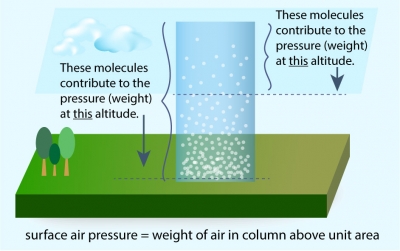
The air around you has weight, and it presses against everything it touches. That pressure is called atmospheric pressure, or air pressure. It is the force exerted on a surface by the air above it as gravity pulls it to Earth.
Atmospheric pressure is commonly measured with a barometer. In a barometer, a column of mercury in a glass tube rises or falls as the weight of the atmosphere changes. Meteorologists describe the atmospheric pressure by how high the mercury rises.
An atmosphere (atm) is a unit of measurement equal to the average air pressure at sea level at a temperature of 15 degrees Celsius (59 degrees Fahrenheit). One atmosphere is 1,013 millibars, or 760 millimeters (29.92 inches) of mercury.
Atmospheric pressure drops as altitude increases. The atmospheric pressure on Denali, Alaska, is about half that of Honolulu, Hawai’i. Honolulu is a city at sea level. Denali, also known as Mount McKinley, is the highest peak in North America.
As the pressure decreases, the amount of oxygen available to breathe also decreases. At very high altitudes, atmospheric pressure and available oxygen get so low that people can become sick and even die.
Mountain climbers use bottled oxygen when they ascend very high peaks. They also take time to get used to the altitude because quickly moving from higher pressure to lower pressure can cause decompression sickness. Decompression sickness, also called “the bends”, is also a problem for scuba divers who come to the surface too quickly.
Aircraft create artificial pressure in the cabin so passengers remain comfortable while flying.
Atmospheric pressure is an indicator of weather. When a low-pressure system moves into an area, it usually leads to cloudiness, wind, and precipitation. High-pressure systems usually lead to fair, calm weather.
Credit: Society
Picture credit: Google




